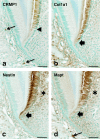Collapsin Response Mediator Protein 1, a Novel Marker Protein for Differentiated Odontoblasts
- PMID: 30647493
- PMCID: PMC6328366
- DOI: 10.1267/ahc.18030
Collapsin Response Mediator Protein 1, a Novel Marker Protein for Differentiated Odontoblasts
Abstract
We previously reported that the terminal differentiation of odontoblasts was inhibited in Runx2 transgenic {Tg(Col1a1-Runx2)} mice under the control of the 2.3-kb Col1a1 promoter. Odontoblasts in Tg(Col1a1-Runx2) mice lose their characteristic long cellular processes, and show marked reductions in the protein levels of markers for odontoblasts, such as dentin sialophosphoprotein, nestin, and microtubule-associated protein tau (Mapt). We herein demonstrated that collapsin response mediator protein 1 (CRMP1), a neuronal phosphoprotein that participates in various aspects of neuronal development, was specifically expressed in the differentiated odontoblasts of wild-type, but not Tg(Col1a1-Runx2) tooth germs by comparing expression profiles in wild-type and Tg(Col1a1-Runx2) mouse molars using microarray and immunohistochemical analyses. CRMP1 expression was detected at a slightly later differentiation stage in odontoblasts than type 1 collagen, nestin, and Mapt expression, which was observed from the onset of dentinogenesis. Among these proteins, CRMP1 was the most specifically localized in odontoblasts in the tooth germ. In erupted molars, odontoblast-specific CRMP1 expression decreased with age. These results indicate that CRMP1 is a novel marker protein for differentiated odontoblasts in mouse tooth germs, and suggest that CRMP1 participates in the morphogenesis of functioning odontoblasts.
Keywords: Runx2; collapsin response mediator protein 1 (CRMP1); odontoblasts.
Figures




Similar articles
-
Microtubule-associated protein tau (Mapt) is expressed in terminally differentiated odontoblasts and severely down-regulated in morphologically disturbed odontoblasts of Runx2 transgenic mice.Cell Tissue Res. 2015 Aug;361(2):457-66. doi: 10.1007/s00441-015-2135-6. Epub 2015 Feb 24. Cell Tissue Res. 2015. PMID: 25707508
-
Inhibition of the terminal differentiation of odontoblasts and their transdifferentiation into osteoblasts in Runx2 transgenic mice.Arch Histol Cytol. 2008 Sep;71(2):131-46. doi: 10.1679/aohc.71.131. Arch Histol Cytol. 2008. PMID: 18974605
-
The role of runt-related transcription factor 2 (Runx2) in the late stage of odontoblast differentiation and dentin formation.Biochem Biophys Res Commun. 2011 Jul 8;410(3):698-704. doi: 10.1016/j.bbrc.2011.06.065. Epub 2011 Jun 15. Biochem Biophys Res Commun. 2011. PMID: 21703228
-
Epigenetic signals during odontoblast differentiation.Adv Dent Res. 2001 Aug;15:8-13. doi: 10.1177/08959374010150012001. Adv Dent Res. 2001. PMID: 12640731 Review.
-
Regulation of bone development and extracellular matrix protein genes by RUNX2.Cell Tissue Res. 2010 Jan;339(1):189-95. doi: 10.1007/s00441-009-0832-8. Epub 2009 Aug 1. Cell Tissue Res. 2010. PMID: 19649655 Review.
Cited by
-
Novel Subgroups of Type 2 Diabetes Display Different Epigenetic Patterns That Associate With Future Diabetic Complications.Diabetes Care. 2022 Jul 7;45(7):1621-1630. doi: 10.2337/dc21-2489. Diabetes Care. 2022. PMID: 35607770 Free PMC article.
-
Establishing an objective clinical spectrum, genotype-phenotype correlations, and CRMP1 as a modifier in the Ellis-van Creveld syndrome: The first systematic review of EVC- and EVC2-associated conditions.Genet Med Open. 2023 Mar 13;1(1):100781. doi: 10.1016/j.gimo.2023.100781. eCollection 2023. Genet Med Open. 2023. PMID: 39669252 Free PMC article. Review.
-
Animal models and related techniques for dentin study.Odontology. 2025 Jan;113(1):42-60. doi: 10.1007/s10266-024-00987-1. Epub 2024 Sep 3. Odontology. 2025. PMID: 39225758 Review.
References
-
- Aberg T., Wang X. P., Kim J. H., Yamashiro T., Bei M., Rice R., Ryoo H. M. and Thesleff I. (2004) Runx2 mediates FGF signaling from epithelium to mesenchyme during tooth morphogenesis. Dev. Biol. 270; 76–93. - PubMed
-
- Arana-Chavez V. E. and Massa L. F. (2004) Odontoblasts: the cells forming and maintaining dentine. Int. J. Biochem. Cell Biol. 36; 1367–1373. - PubMed
-
- Balic A. and Thesleff I. (2015) Tissue interactions regulating tooth development and renewal. Curr. Top. Dev. Biol. 115; 157–186. - PubMed
-
- Bleicher F., Couble M. L., Buchaille R., Farges J. C. and Magloire H. (2001) New genes involved in odontoblast differentiation. Adv. Dent. Res. 15; 30–33. - PubMed
LinkOut - more resources
Full Text Sources
Research Materials
Miscellaneous

